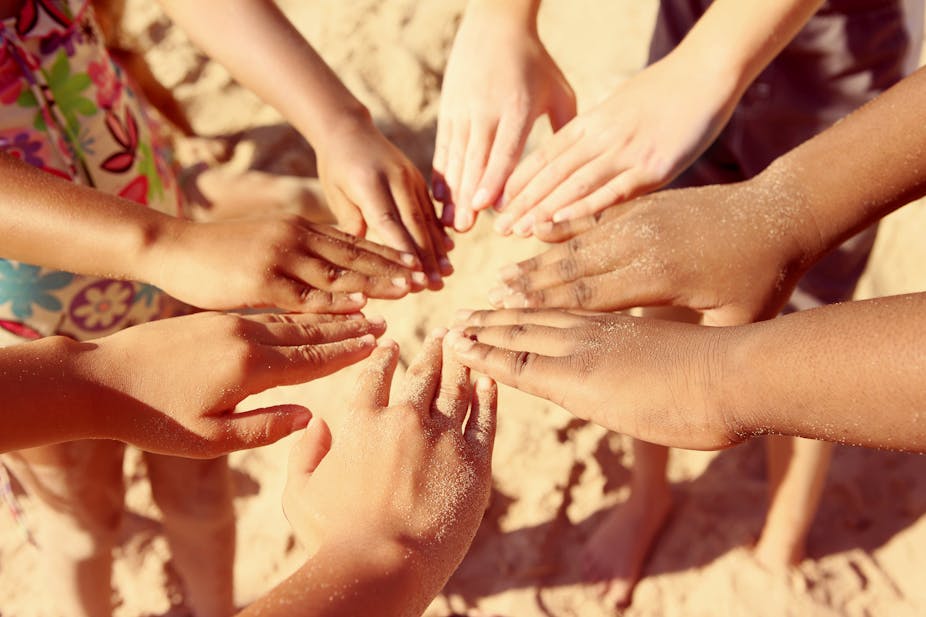Race-related demonstrations, Title IX disputes, affirmative action court cases, same-sex marriage bans.
These issues made headlines in all spheres of the media this year. However, thoughtful articles on these subjects seem always to devolve to pitting warring factions against each other: black vs white, women vs men, gay vs straight.
At the most fundamental level of biology, we recognize the innate advantage of defining differences in species. But even within species, is there something in our neural circuits that leads us to find comfort in those like us and unease with those who may differ?
Brain battle between distrust and reward
Like all animals, our brains balance two primordial systems: one that includes a brain region called the amygdala that generates fear and distrust of those things that pose a danger (think predators); the other, a group of connected structures called the mesolimbic system, that gives rise to pleasure and feelings of reward that make it more likely we will flourish and survive (think food). But how do these systems interact to influence how we form our concepts of community?
Through implicit association tests which uncover the strength of subliminal associations – for example, white=good, black=bad – scientists have shown that many of us harbor an implicit preference for our in-group (those like us), even when we show no outward or obvious signs of bias. Are such associations learned? Are they in some way hardwired? And either way, do they reflect conflicting activity of the amygdala vs the mesolimbic system?

Distrust of ‘others’
Research into how the amygdala responds when we assess the relative importance of race is nuanced and complex. Studies must take into account the differences between explicit and implicit measures of race attitudes, as well as the impact of cultural bias and individual variation. Still, most research suggests that signaling variations within the amygdala are responsible for the way we measure trust in implicit in-group vs out-group preference.
Reward from ‘sameness’
Reward, on the other hand, is encoded in our brains by loops of neurons within a circuit called the mesolimbic system. These neurons control the release of the transmitter dopamine, which is associated with an enhanced sense of pleasure. The addictive nature of some drugs, gaming and gambling depends on increases in the activity of these neurons.
The neural circuits that govern social behavior and reward arose early in vertebrate evolution and are present in birds, reptiles, bony fishes and amphibians, as well as mammals. So far there’s not a lot of information on reward pathway activity in people during in-group vs out-group social situations, but there are some tantalizing results from studies on these other animals.
In recent work, neuroscientist Karl Deisseroth and his colleagues at Stanford combined genetics and behavioral tests with a cutting-edge approach called fiber photometry where light can turn on and off specific cells. Using this process, the researchers were able to both stimulate and measure activity in identified neurons in the reward pathways, with an exquisite degree of precision. As important, they were able to do this in mice as they behaved in social settings.
They showed that neural signaling in a specific group of these dopamine neurons within these mesolimbic reward loops are jazzed up when a mouse encounters a new mouse – one it’s never met before, but that is of its own genetic line. Is this dopamine reward reaction the mouse corollary of human in-group recognition?

What if the mouse were of a different genetic line with different external characteristics? What about with other small mammals such as voles who have dramatically different social relationships depending upon whether they are the type that lives in the prairie or in the mountains? Would the mesolimbic neurons still light up in recognition, or would the differences tip the balance toward the amygdala expressing fear and distrust?
We don’t know how these subtle differences in animals might affect how their neural circuits promote social responses, but by studying them, we may better understand how our own brain systems contribute to the implicit and unconscious bias we feel towards those in our own species who are nonetheless somewhat different.

Neural signaling is not destiny
Even if evolution has tilted the balance toward our brains rewarding “like” and distrusting “difference,” this need not be destiny. Activity in our brains is malleable, allowing higher order circuits in the cortex to modify the more primitive fear and reward systems to produce different behavioral outcomes.
Author Chimamanda Ngozi Adichie eloquently relates that:
the problem with stereotypes is not that they are untrue, but that they are incomplete. They make one story become the only story.
Stereotypes reduce those not exactly like us to only their differences.
Diversity’s value
Why would we put up with the discomfort that differences evoke, rather than always selecting the easy reward with sameness? In his book, The Difference, Scott Page provides mathematical evidence that although diverse individuals are less trusting of one other, when working together, they are more productive.
From cracking the Enigma code in WWII to predicting stock prices, Page provides data to demonstrate that a diversity of perspectives produces better innovation and better solutions than the smartest set of like-minded experts. In short, diversity trumps ability.
So let’s acknowledge the amygdalar distrust that differences evoke. Then, while we may not get that same boost of dopamine, let’s recognize that when it comes to what will promote the greatest good, working with those “not like us” has its own rewards.

